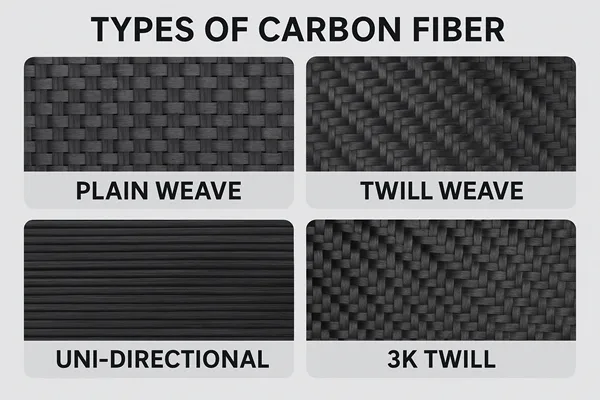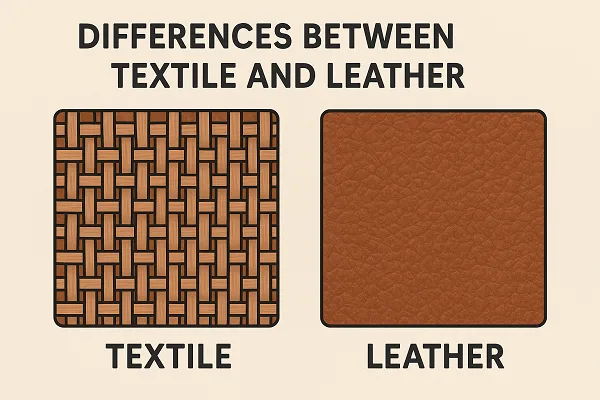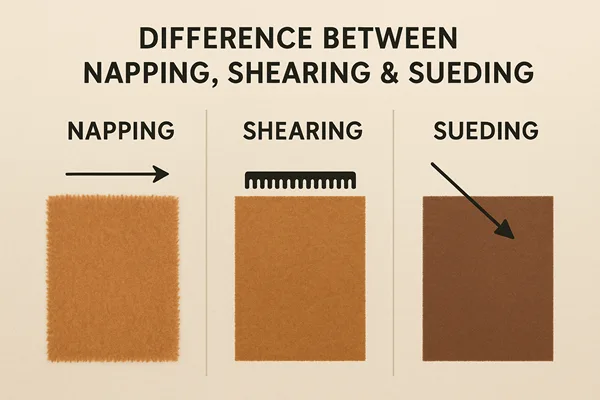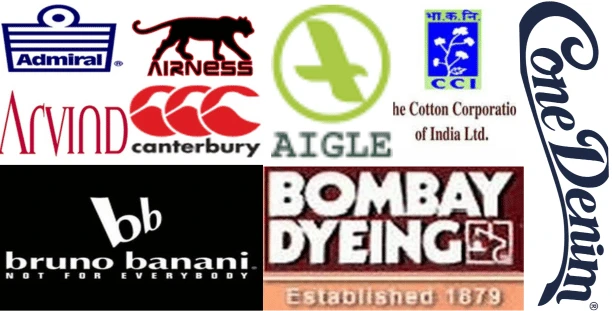Different Types of Carbon Fiber
As the name suggests, carbon fiber consists mostly of carbon atoms. They are about 5 to 10 micrometers. There are different types of carbon fiber. Each type is great for high stiffness, tensile strength, low weight, and high chemical resistance. Carbon fibers are generally used for composite materials. Carbon is combined with plastic resin and baked to make a carbon-fiber reinforced composite, while it can be combined with graphite to make a reinforced carbon-carbon composite for higher strength.

Different Types of Carbon Fiber
There are different types of carbon fiber based on modulus, tensile strength (Fiber Materials), and final heat treatment temperature. In the carbonization process, temperature exposures range from 1000°C to 2000°C, each different level of exposure creating a different property for fiber. For example, high modulus type is processed at 2000°C, 1500°C for high strength type, and 1000°C for low modulus and low strength type.
Carbon fiber is a lightweight, high-strength material known for its exceptional durability and performance. Some carbon fiber-related products are given below:
1. Car Wrap Vinyl
Transform your vehicle’s appearance with a sleek and modern touch using car wrap vinyl. With its carbon fiber texture, this vinyl adds a dynamic and sporty look to your car while providing protection against scratches and fading. Available in a range of colors and finishes, car wrap vinyl allows you to personalize your ride and make a bold statement on the road.
2. Carbon Fiber Sheet
If you’re a DIY enthusiast or looking to add a touch of carbon fiber elegance to your projects, carbon fiber sheets are a fantastic choice. These sheets are lightweight yet incredibly strong, making them perfect for various applications, from customizing interior panels and trim to creating unique jewelry and crafts. With their distinctive weave pattern and glossy finish, carbon fiber sheets add a high-end and modern aesthetic to any project.
3. Carbon Fiber Wallet
Combine style and functionality with a sleek carbon fiber wallet. Designed with modern minimalism in mind, carbon fiber wallets are slim, lightweight, and highly durable. They offer excellent protection for your credit cards and personal information with built-in RFID-blocking technology, safeguarding you against electronic theft. With their sleek and sophisticated appearance, carbon fiber wallets make a statement of refined taste while providing practical organization for your essentials.
Types of carbon fiber depending on Modulus
- Ultra High modulus ( Modulus > 500GPa ) Ex: Pitch
- High modulus ( Modulus 300-500GPa ) Ex: PAN
- Intermediate modulus ( Modulus 100-300GPa ) Ex: PAN
- Low modulus ( Modulus < 100GPa ) Ex: Isotropic Pitch, Rayon-based carbon fiber
Types of carbon fiber depending on Fiber Materials
- PAN-based carbon fiber
- Pitch-based carbon fiber
- Mesophase pitch-based carbon fiber
- Isotropic pitch-based carbon fiber
- Rayon-based carbon fiber
The main carbon fibers are made from Poly Acrylonitrile (PAN) based and pitch-based formulation, and they are well-known for their composite reinforcement and heat heat-resistant, and uses.
| Carbon fiber properties | PAN | PITCH |
| Tenacity g/de | 18-70 | 14-30 |
| Modulus g/de | 1640-3850 | 1000-5850 |
| Elongation % | 0.4-2.4 | 0.2-1.3 |
| Continuous operation temperature °F | 570-1000 | 570-1000 |
Types of carbon fiber depending on Final Heat Treatment Temperature
- Type I: In this case of the carbon fiber final heat treatment temperature remains above 2000°C. This type of carbon fiber is a high modulus type of fiber.
- Type II: Final heat treatment temperature for this type incorporates around or above 1500°C, and this temperature yields high-strength type carbon fiber.
- Type III: Final heat treatment temperature for this type incorporates around or below 1000°,C and this temperature yields low-strength type carbon fiber.
How is carbon fiber made?
Most of the carbon fiber is manufactured from polyacrylonitrile (PAN), rayon or pitch based polymer. 90% carbon fiber is manufactured from PAN and the rest is from rayon or pitch based polymer. Polymers used to manufacture this fiber is called Precursor. These organic polymers are long chain molecules bounded by carbon atoms. For different manufacturers, precursor composition and mechanical process used during spinning of the filament may vary.
Carbon fiber synthesis can be categorized into five phases:
Step-1: Spinning
- Polycrylonitrile is formed from acrylonitrile plastic powder mixed with other plastic fibers, such as methyl acrylate or methyl methacrylate. This process incorporates suspension or solution polymerization, where the mixture is reacted with a catalyst.
- Then it is spun into filament using one of the spinning methods. It may include the plastic mixing with some chemicals that can be pumped through jets and passed through the quenching chamber to solidify into fiber, or the plastic mixing with some chemicals is pumped through tiny jet where the solvents evaporate, leaving solid fibers. The internal atomic structure of the fiber is formed in this process.
- Fibers are then washed off and stretched to the preferred diameter.
Step-2: Stabilization (up to 300°C)
- Stabilization is required to chemically alter the fibers before they pass for carbonization process. Here, the linear atomic bond is converted to a more thermally stable ladder bond.
- This is accomplished by heating the fibers in air to about 390-590° F (200-300° C) for 30-120 minutes. Here, fibers collect oxygen molecules from the air and rearrange their molecular patterns.
- In this process, the fibers are drawn through a series of heated rollers or chambers. Again, heated air mixed witha certain gas can also be used to accelerate the stabilization process.
Step-3: Carbonizing
- After stabilization, the fibers are heated up to 1830 – 5000°F (up to 1000-3000°C) for several minutes in a furnace containing a gas mixture that doesn’t contain oxygen. Inside the furnace, air pressure is kept higher than the outside atmospheric pressure.
- The entrance and exit options of the furnace are sealed so that oxygen can’t enter it. The absence of oxygen prevents the fibers from burning at a higher temperature.
- Through this heating procedure, fibers lose their non-carbon atom and add a few new carbon atoms. This addition can be done from gases like carbon monoxide, carbon dioxide, etc.
- Once the non-carbon atoms are lost, the remaining carbon atoms are tightly bonded to gather to form carbon crystals that are more or less aligned parallel to the fiber’s long axis.
Step-4: Surface Treatment
- Once the carbonizing is completed, the fibers have such a surface that can’t make bonds well with epoxies or other materials present in the composite. For better bonding properties, their surface is slightly oxidized.
- Oxygen atoms are added to the surface to provide better chemical bonding properties. It also etches and roughens the surface for better mechanical properties.
- By immersing the fibers in various gases such as air, carbon dioxide, ozone, and oxygen is achieved. The fibers can also be coated with electrically conductive materials.
- This treatment should be carefully controlled so that no tiny surface defects can form, such as pits.
Step-5: Sizing
- Finally, the fibers are coated to protect them from damage during the weaving or winding process. This is called the sizing process.
- Coating materials should be compatible with the adhesive used in composite materials. Typical coating materials include epoxy, polyester, nylon, urethane, etc.
The coated fibers are wound onto bobbins that are loaded into a spinning machine, which then twists to form yarns.
To Wrap Up!
Different Types of Carbon fiber are the fiber of the future. Many high-tech items, such as cars or even airplanes, are made up of carbon fiber nowadays. Carbon fiber is a crucial material due to its exceptional strength-to-weight ratio, high stiffness, and resistance to corrosion and fatigue. These properties make it ideal for a wide range of applications, including aerospace, automotive, construction, and sporting goods, where performance and durability are paramount.



